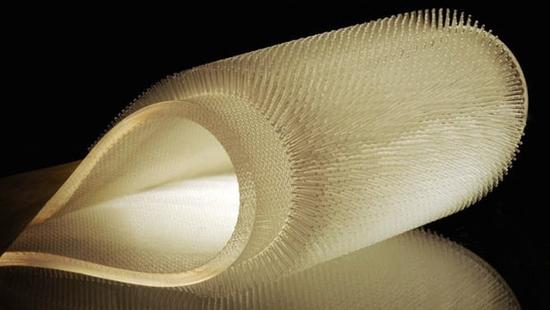(单词翻译:单击)
听力文本
This is Scientific American — 60-Second Science. I'm Cynthia Graber.
Whales, seals and walruses stay warm in chilly water because they have a thick layer of blubber. We humans rely on something like blubber—neoprene rubber wet suits—to spend time in cold water. But the thick versions for really icy water are heavy and ungainly. So rather than taking after big marine mammals, what if we could learn from the littler ones, like beavers and otters?
"These animals are quite small and they can't carry around a thick layer of blubber. So instead they have fur that is evolved to trap air, and this air provides a layer of insulation for them in water."
Alice Nasto is a graduate student in mechanical engineering at MIT. Scientists have known about this air-trapping insulation mechanism for a long time, but they had not teased out the details of how it works. So Nasto and her colleagues took on the challenge.
"We're creating these furry samples from these rubbery materials by laser cutting molds and casting these hairy surfaces. And through our approach we can precisely control the spacing of the hairs and the length of the hairs."

The researchers then created a system to gather data when their pelts entered and moved through a liquid—in this case not water, but silicone oil, which makes it easier to see air bubbles. The key is to keep the pelt's air layer intact.
"So when they're crossing the air water interface, initially their hairy texture is full of air. And then you go into water. How much of the air comes down with you as you're moving in through the interface. So that's what this model will tell you."
They found that the denser the hairs, the more the air gets trapped. Which should keep the animal—or potentially the human in a future furry wet suit—warm. The research is in the journal Physical Review Fluids.
"What we would like to work on moving forward is understanding how, after you dive into the water, how do you maintain this air layer trapped in your fur. And there's lots of interesting properties of the fur in nature that we haven't yet looked at in our model that could help explain how this mechanism might work."
So for now, cold-water divers and surfers will still emulate seals or sea lions. But the day may come when they'll more closely resemble otters or beavers. Or even a Wookiee on a boogie board.
Thanks for listening for Scientific American — 60-Second Science Science. I'm Cynthia Graber.
参考译文
这里是科学美国人——60秒科学。我是辛西娅·格雷伯。
鲸鱼,海豹和海象可以在寒冷的水中维持体温,因为它们有很厚的脂肪层。我们人类则可以依靠类似于脂肪的氯丁橡胶潜水服在冰冷的水中活动。可是在冰水中穿着厚厚的潜水服又沉重又笨拙。那除了效仿大型海洋哺乳动物,向河狸和水獭等小型海洋哺乳动物学习是否也可以呢?
“这些动物都很小,它们没有厚厚的脂肪层。所以它们进化出了可以存留空气的皮毛,存留的空气为它们在水中活动时提供了隔热层。”
爱丽丝·纳斯托是麻省理工学院机械工程专业的研究生。科学家们很早就发现了这种存留空气形成的隔热机制,但是他们并没有测试出这种机制的具体原理。所以纳斯托和她的同事们接受了这项挑战。
“我们用激光切割模具将这些橡胶材料制成了毛皮样本,然后铸造出这些毛茸茸的表面。通过这种方法,我们可以精确地控制毛发间的距离以及毛发的长度。”
然后,研究人员创建了一个系统,在毛皮进入液体并在液体里移动时收集相关数据,这种液体并不是水,而是硅油,用硅油更易在试验过程中看到气泡。关键是要保持毛皮空气层的完整性。
“当它们穿过气液界面时,一开始毛发材质充满了空气。然后,把它们投入液体中。当你移动它穿过气液界面时,你可以带动多少空气?这就是我们设计的模型会告诉大家的事情。”
他们发现,毛发的密度越大,存留的空气就越多。这就可以使动物保持温暖,或许未来也可以使穿着毛皮潜水服的人类保暖。该研究结果发表在《流体物理评论》期刊上。
“我们接下来想继续研究的是,在你跳入水中后,如何让这个空气隔热层一直存留在毛皮里。在我们设计的这个模型中,这种毛皮的许多有趣特点我们还没有研究,进一步了解它们也许能够解释这种机制的原理。”
现在,冷水潜水员或冲浪者仍会继续模仿海豹和海狮。而他们模仿水獭或者海狸的那一天终将会到来的。也许你甚至会看到玩冲浪板的“伍基人”。
谢谢大家收听科学美国人——60秒科学。我是辛西娅·格雷伯。
译文为可可英语翻译,未经授权请勿转载!
重点讲解
重点讲解:
1. rely on 依赖;依靠;
例句:Most people rely on their own efforts.
大部分人靠的是自己的努力。
2. take after 效仿;
例句:He'd got a way of his own and I tend to take after him.
他有自己的一套方式,我想效仿他。
3. take on 承担,接受(尤指艰巨工作或重大责任);
例句:He has the courage to take on important tasks.
他勇于担当重任。
4. be full of 有大量…的;满是…的;
例句:The past year was full of troubles.
过去的一年充满着困难。


